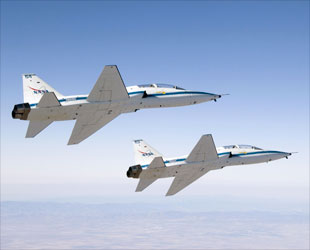September 7, 2011 — NASA's astronaut corps is too few in number, posing a risk to the U.S. investment in human spaceflight capabilities, a new report released Wednesday (Sept. 7) finds.
According to the National Research Council (NRC), which conducted the study at NASA's request, current plans for retaining and hiring astronauts do not provide "sufficient flexibility" to reliably meet the projected requirements of the International Space Station (ISS).
"With the retirement of the space shuttle program and the uncertainty during the transition to a fully operational ISS, it's even more important that the talent level, diversity, and capabilities of the astronaut office be sustained," Joe Rothenberg, co-chair of the NRC committee that wrote the report and a former senior NASA official, said. "Making sure NASA maintains adequate training facilities is also essential to ensure a robust astronaut corps."
According to the council's report, which is titled "Preparing for the High Frontier: The Role and Training of NASA Astronauts in the Post- Space Shuttle Era," the number of astronauts in NASA's corps has substantially reduced in recent years — from nearly 150 in 2000 to 61 astronauts in 2011. Much of this decrease was due to the planned retirement of the shuttle and the transition from building to operating the ISS.
NASA's most recent astronaut selection was conducted in 2009. Nine U.S. candidates were selected and are now just completing their basic training and receiving their first ISS flight assignments.
Astronaut supply chain
The model that NASA uses to predict minimum staffing requirements can't fully account for uncertainties, such as retirements and medical disqualifications. NASA factors in a margin therefore, to calculate astronaut requirements.
The report recommends increasing the margin to estimate these management needs in order to maintain a mission ready fleet of trained professionals who can safely operate the space station.
"Viewed as a supply chain, astronaut selection and training is very sensitive to critical shortfalls; astronauts who are trained for specific roles and missions can't be easily interchanged," committee co-chair Fred Gregory, a former three-time shuttle astronaut who also served as NASA's deputy administrator, said.
While the retirement of the shuttle program last month has reduced certain training requirements, operating the ISS imposed many complicated new ones that take years of training, the committee found.
U.S. crew members must now be familiar not only with NASA equipment on the station but also with European, Japanese, and Russian station modules and equipment. They must also be proficient with space station software, peforming spacewalks, using the station's robotic arm and numerous other tasks.
Astronauts' health, especially over long-duration flights, is another significant factor determining staffing needs, the report says. Health requirements are stringent to prevent the early termination of station expeditions out of medical necessity.
Thirteen astronauts have become medically ineligible for long-duration missions after being assigned to a mission but before they could actually fly, which the committee found made clear the need for adequate replacement staff with a range of skills. Also, due to a variety of medical conditions including vision problems, bone loss, physical injuries, or radiation exposure, not all astronauts returning from long-duration flights will re-qualify for space station expeditions.
The need for speed
The report also stressed the need for NASA to retain its crew-related ground facilities in the post-space shuttle era, including the astronaut corps' fleet of T-38N "Talon" two seat training jet aircraft.

NASA T-38N Talon astronaut trainers fly in formation. (NASA) |
Emergency response in an aircraft environment has been shown to ready astronauts for anomalies in actual space flight, the report says. The aircraft help the astronauts develop the skills and ability to work together during fast paced, physically stressful situations with the potential for severe penalties for failure.
Astronauts flying in the back seat of the aircraft train for critical tasks such as communications, navigation, and emergency response in a demanding environment that cannot be effectively simulated by other means.
Although there remains some uncertainty about the the future direction of NASA's human spaceflight program, the committee was not tasked to address whether or not it should continue, or what form it should take. As a result, factors such as the role that astronauts have traditionally played in the development of new spacecraft were not considered in the report's recommendations.
In addition to Gregory, the NRC Committee on Human Spaceflight Crew Operations included four other former astronauts among its 13 members.
The committee received cooperation and assistance from NASA's Flight Crew Operations Directorate, including from the chief of the Astronaut Office.
In addition, the committee sought and received input from potential providers of future commercially procured human spacecraft, including SpaceX and Sierra Nevada Corp., as well as the Federal Aviation Administration (FAA), which is expected to play a role in licensing future commercial human spacecraft. The committee also received briefings on training practices of the Naval Reactors Program and the commercial airline industry.
Download the National Research Council report Preparing for the High Frontier from the National Academies Press.
